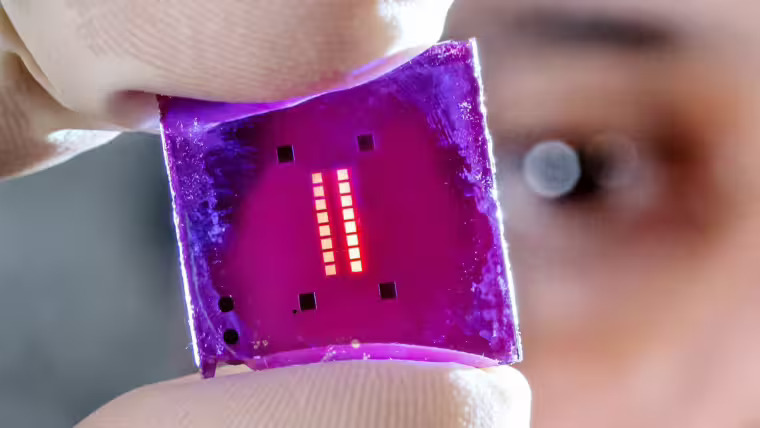A material coating, whose light refraction properties can be precisely switched between different states, has been developed by an interdisciplinary research team from the Chemistry and Physics departments at the University of Jena. The team, led by professors Felix Schacher and Isabelle Staude, combined light-reactive polymers with metasurfaces. The work has led to the creation of new optical components that could see use in signal processing.

As light hits this photo-tunable polymer metasurface, properties like its refractive index are changed, depending on the incident light’s wavelength. Courtesy of Jens Meyer/University of Jena.
Optical metasurfaces are nanostructured thin layers whose characteristic structural sizes are smaller than the wavelength of light. This allows the properties of light and its propagation to be specifically influenced, enabling a variety of optical functions that would otherwise be performed by lenses, polarizers, or gratings. On the other hand, switchable polymers are plastics whose properties, such as the light refraction index, can change between different states.
“Both metasurfaces and light-switchable polymers have been known in principle for decades, but we are the first to combine both in this form to develop new components for optical applications,” said then postdoctoral researcher Sarah Walden, now a professor at Griffith University.
According to Felix Schacher from the Institute of Organic Chemistry and Macromolecular Chemistry, the team used polymers containing dye molecules that absorbed a specific wavelength of light. This allowed them to change their structure and properties, including the refractive index of light. To switch the dye back to its previous structure with the corresponding property, light of a different wavelength is required.
“What's special about our system is that the changes in refractive index affect the optical properties of the meta-surface when it is coated with such a polymer,” said professor Isabelle Staude. The changes achieved were surprisingly significant, even compared to previously known similar systems. “Since all of the polymers absorb differently depending on which dye is used, a number of effects can be separated or combined.”

(From left) Professor Felix H. Schacher, Purushottam Poudel, Sarah Walden, and professor Isabelle Staude. Courtesy of Jens Meyer/University of Jena.
In addition to demonstrating the optical properties of the switchable metasurfaces, the team found chemical effects which will require further investigation.
“In our work, we used two different dyes separately, each applied to a metasurface. This confirmed the effect,” Schacher said. “However, when mixing both switchable polymers, additional effects occur. We suspect that the two different dye molecules interact with each other, but we cannot say for certain at this point.”
Although the primary focus of the work was to demonstrate the basic principle of these switchable surfaces, the research group envisions several applications for the technology.
“Since these surfaces can switch between different property states with light, sensor technology is a natural application area,” said Schacher. The devices could also find use in optical data processing, and potentially in neural networks, enabling image information to be processed in the same way that electronic-based AI does now. “However, because this type of data processing is based on light rather than electronics, it is significantly more energy-efficient and faster than traditional computer-based AI.”
The research was published in ACS Nano (www.doi.org/10.1021/acsnano.3c11760).